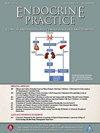Comprehensive Analysis of Mitotane-Related Adverse Events Using the Food and Drug Administration Adverse Event Reporting System
IF 3.7
3区 医学
Q2 ENDOCRINOLOGY & METABOLISM
引用次数: 0
Abstract
Objective
Mitotane is currently the only product approved by the Food and Drug Administration for the treatment of adrenocortical cancer. However, there is a lack of comprehensive studies on the adverse events of mitotane.
Methods
Adverse event reports for mitotane in the Food and Drug Administration Adverse Event Reporting System database since 2004 were collected and analyzed to identify mitotane as the primary suspect drug. Reporting ratios, multi-item γ Poisson constrictors, proportional reporting ratios, and Bayesian confidence propagation neural networks were used to analyze the disproportionality of mitotane-related adverse events.
Results
A total of 21 433 114 adverse event reports were retrieved from the Food and Drug Administration Adverse Event Reporting System database, with 772 cases identified where mitotane was the primary suspected drug. Positive signals were observed for adverse reactions listed on the drug label, such as nausea, diarrhea, vomiting, dizziness, loss of appetite, and adrenal insufficiency. Additionally, potential adverse reactions not specified on the label were detected, including fatigue, malignant tumor progression, ovarian cysts, chills, amnesia, and Q-T interval prolongation on the electrocardiogram. These findings highlight the critical need for vigilant monitoring of adverse events, particularly during the first few months of treatment.
Conclusion
This study provides preliminary safety data on the practical application of mitotane, confirming some known adverse reactions and revealing other potential risks. These findings provide critical safety information for clinicians prescribing mitotane for the treatment of adrenocortical cancer.
利用 FDA 不良事件报告系统全面分析与米托坦相关的不良事件
目的:米托坦是目前美国食品及药物管理局批准用于治疗肾上腺皮质癌的唯一产品。然而,目前还缺乏对米托坦不良事件的全面研究:方法:收集并分析自 2004 年以来 FDA 不良事件报告系统数据库中有关米托坦的不良事件报告,以确定米托坦为主要可疑药物。使用报告比率、多项目γ泊松收缩因子、比例报告比率和贝叶斯置信度传播神经网络来分析与米托坦相关的不良事件的比例失调情况:从 FAERS 数据库中共检索到 21,433,114 份不良事件报告,其中 772 个病例的主要可疑药物是米托坦。在药物标签上列出的不良反应,如恶心、腹泻、呕吐、头晕、食欲不振和肾上腺功能不全等,都出现了阳性信号。此外,还发现了标签上未列明的潜在不良反应,包括疲劳、恶性肿瘤进展、卵巢囊肿、寒战、健忘和心电图 QT 间期延长。这些发现强调了警惕不良事件的重要性,尤其是在治疗的最初几个月:本研究提供了有关米托坦实际应用的初步安全性数据,证实了一些已知的不良反应,并揭示了其他潜在风险。这些发现为临床医生处方米托坦治疗肾上腺皮质癌提供了重要的安全信息。
本文章由计算机程序翻译,如有差异,请以英文原文为准。
求助全文
约1分钟内获得全文
求助全文
来源期刊

Endocrine Practice
ENDOCRINOLOGY & METABOLISM-
CiteScore
7.60
自引率
2.40%
发文量
546
审稿时长
41 days
期刊介绍:
Endocrine Practice (ISSN: 1530-891X), a peer-reviewed journal published twelve times a year, is the official journal of the American Association of Clinical Endocrinologists (AACE). The primary mission of Endocrine Practice is to enhance the health care of patients with endocrine diseases through continuing education of practicing endocrinologists.
 求助内容:
求助内容: 应助结果提醒方式:
应助结果提醒方式:


